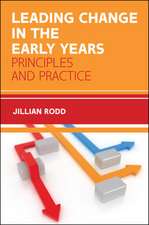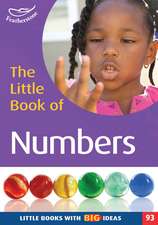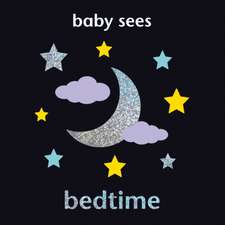The Developing Brain: Birth to Age Eight
Editat de Marilee B. Sprengeren Limba Engleză Paperback – apr 2008
Beaverton School District, OR
"The author has managed to untangle a very complex topic and make it applicable to everyday learning and teaching. The continuous application of research to learning is a strength of the book. A true gift to a broad band of educators."
—Laura Linde, Literacy Coach
Hoover Elementary School, North Mankato, MN
Finally, a book for early childhood educators that combines child development and brain research!
How can early childhood teachers, administrators, and parents translate discoveries on early brain development into strategies that nurture cognitive growth? Synthesizing information from neuroscience, cognitive psychology, and child development, The Developing Brain offers brain-compatible teaching practices that are linked to NAEYC principles for working with young children.
Best-selling author Marilee Sprenger covers the basic structure, vocabulary, and current research on the brain from an early childhood educator's point of view and provides an abundance of illustrations and descriptions. This user-friendly guide includes:
Background information on brain development from birth through age two
Scenarios and snapshots of each year from age three through eight
Reproducible developmental checklists
Over 100 brain-based activities for classroom or child care settings
Through an understanding of the phases of language, motor, and social development at each age level, educators can create enriching educational experiences that enhance children's growth and foster an enduring love of learning.
| Toate formatele și edițiile | Preț | Express |
|---|---|---|
| Paperback (1) | 294.50 lei 6-8 săpt. | |
| SAGE Publications – apr 2008 | 294.50 lei 6-8 săpt. | |
| Hardback (1) | 483.47 lei 6-8 săpt. | |
| SAGE Publications – 21 apr 2008 | 483.47 lei 6-8 săpt. |
Preț: 294.50 lei
Nou
Puncte Express: 442
Preț estimativ în valută:
56.36€ • 61.20$ • 47.34£
56.36€ • 61.20$ • 47.34£
Carte tipărită la comandă
Livrare economică 23 aprilie-07 mai
Preluare comenzi: 021 569.72.76
Specificații
ISBN-13: 9781412955355
ISBN-10: 1412955351
Pagini: 144
Ilustrații: black & white tables, figures
Dimensiuni: 216 x 279 x 10 mm
Greutate: 0.41 kg
Ediția:1
Editura: SAGE Publications
Colecția Corwin
Locul publicării:Thousand Oaks, United States
ISBN-10: 1412955351
Pagini: 144
Ilustrații: black & white tables, figures
Dimensiuni: 216 x 279 x 10 mm
Greutate: 0.41 kg
Ediția:1
Editura: SAGE Publications
Colecția Corwin
Locul publicării:Thousand Oaks, United States
Recenzii
"I truly enjoyed the book and had trouble putting it down. The developmental checklists at the end of each chapter are awesome! I have pored over them and learned so much about my children, niece, and neighbors. Thanks for providing such a neat way to communicate expectations and guidelines."
"The author has managed to untangle a very complex topic and make it applicable to everyday learning and teaching. The continuous application of research to learning is a strength of the book. A true gift to a broad band of educators."
"This tool shows how classrooms can differentiate instruction, spend time on what really matters, and make sure that all children are making progress. I love the practical applications for each age level and what teachers can do to support optimal learning in their classrooms. Fantastic!"
"The author took difficult information on the brain and synthesized it so that it is reader-friendly and easy to understand. She provided ideas that could easily be implemented in a classroom or at home and identified the curriculum areas for growth."
"Chapters cover the basic research on the brain as it relates to educators and child development issues, pairing this survey with development checklists and over 100 brain-based activities for classroom or child care environments."
"The author has managed to untangle a very complex topic and make it applicable to everyday learning and teaching. The continuous application of research to learning is a strength of the book. A true gift to a broad band of educators."
"This tool shows how classrooms can differentiate instruction, spend time on what really matters, and make sure that all children are making progress. I love the practical applications for each age level and what teachers can do to support optimal learning in their classrooms. Fantastic!"
"The author took difficult information on the brain and synthesized it so that it is reader-friendly and easy to understand. She provided ideas that could easily be implemented in a classroom or at home and identified the curriculum areas for growth."
"Chapters cover the basic research on the brain as it relates to educators and child development issues, pairing this survey with development checklists and over 100 brain-based activities for classroom or child care environments."
Cuprins
Preface: You Don't Know Jack!
Acknowledgments
About the Author
Introduction
What Is Best Practice?
Brain-Compatible Teaching Principles
Early Childhood Practices
An Ounce of Prevention
About This Book
1. The Basic Biology of Brain Development
Brain Chemicals
Electroencephalograms
Windows of Opportunity
Experience Dependent and Experience Expectant
First Language
Second Language Learning
Motor Development
Memory Development
Music
Math
Emotion
Thinking About Brain Growth
2. Building the Brain Through Age Two
Brain Development
Language and Reading Development
Physical and Motor Development
Gross Motor Skills
Fine Motor Skills
Social and Emotional Development
Cognitive Development
Developmentally Appropriate Activities From Birth to Age Two
Reading and Language Development
Physical and Motor Development
Cognitive Development
3. The Three-Year-Old Brain
Brain Development
Language and Reading Development
Physical and Motor Development
Social and Emotional Development
Cognitive Development
Developmentally Appropriate Activities for Three-Year-Old Brains
For Language and Reading Development
For Physical and Motor Development
For Social and Emotional Development
For Cognitive Development
Child Development Checklist: Three-Year-Olds
4. The Four-Year-Old Brain
Brain Development
Language and Reading Development
Physical and Motor Development
Social and Emotional Development
Cognitive Development
Developmentally Appropriate Activities for Four-Year-Old Brains
For Language and Reading Development
For Physical and Motor Development
For Social and Emotional Development
For Cognitive Development
Child Development Checklist: Four-Year-Olds
5. The Five-Year-Old Brain
Scenario
Brain Development
Language and Reading Development
Physical and Motor Development
Social and Emotional Development
Cognitive Development
Developmentally Appropriate Activities for Five-Year-Old Brains
For Language and Reading Development
For Physical and Motor Development
For Social and Emotional Development
For Cognitive Development
Child Development Checklist: Five-Year-Olds
6. The Six-Year-Old Brain
Scenario
Brain Development
Language and Reading Development
Physical and Motor Development
Social and Emotional Development
Cognitive Development
Developmentally Appropriate Activities for Six-Year-Old Brains
For Language and Reading Development
For Physical and Motor Development
For Social and Emotional Development
For Cognitive Development
Child Development Checklist: Six-Year-Olds
7. The Seven-Year-Old Brain
Scenario
Brain Development
Language and Reading Development
Physical and Motor Development
Social and Emotional Development
Cognitive Development
Developmentally Appropriate Activities for Seven-Year-Old Brains
For Language and Reading Development
For Physical and Motor Development
For Social and Emotional Development
For Cognitive Development
Child Development Checklist: Seven-Year-Olds
8. The Eight-Year-Old Brain
Brain Development
Language and Reading Development
Physical and Motor Development
Social and Emotional Development
Cognitive Development
Developmentally Appropriate Activities for Eight-Year-Old Brains
For Language and Reading Development
For Physical and Motor Development
For Social and Emotional Development
For Cognitive Development
Child Development Checklist: Eight-Years-Old
Bibliography
Index
Acknowledgments
About the Author
Introduction
What Is Best Practice?
Brain-Compatible Teaching Principles
Early Childhood Practices
An Ounce of Prevention
About This Book
1. The Basic Biology of Brain Development
Brain Chemicals
Electroencephalograms
Windows of Opportunity
Experience Dependent and Experience Expectant
First Language
Second Language Learning
Motor Development
Memory Development
Music
Math
Emotion
Thinking About Brain Growth
2. Building the Brain Through Age Two
Brain Development
Language and Reading Development
Physical and Motor Development
Gross Motor Skills
Fine Motor Skills
Social and Emotional Development
Cognitive Development
Developmentally Appropriate Activities From Birth to Age Two
Reading and Language Development
Physical and Motor Development
Cognitive Development
3. The Three-Year-Old Brain
Brain Development
Language and Reading Development
Physical and Motor Development
Social and Emotional Development
Cognitive Development
Developmentally Appropriate Activities for Three-Year-Old Brains
For Language and Reading Development
For Physical and Motor Development
For Social and Emotional Development
For Cognitive Development
Child Development Checklist: Three-Year-Olds
4. The Four-Year-Old Brain
Brain Development
Language and Reading Development
Physical and Motor Development
Social and Emotional Development
Cognitive Development
Developmentally Appropriate Activities for Four-Year-Old Brains
For Language and Reading Development
For Physical and Motor Development
For Social and Emotional Development
For Cognitive Development
Child Development Checklist: Four-Year-Olds
5. The Five-Year-Old Brain
Scenario
Brain Development
Language and Reading Development
Physical and Motor Development
Social and Emotional Development
Cognitive Development
Developmentally Appropriate Activities for Five-Year-Old Brains
For Language and Reading Development
For Physical and Motor Development
For Social and Emotional Development
For Cognitive Development
Child Development Checklist: Five-Year-Olds
6. The Six-Year-Old Brain
Scenario
Brain Development
Language and Reading Development
Physical and Motor Development
Social and Emotional Development
Cognitive Development
Developmentally Appropriate Activities for Six-Year-Old Brains
For Language and Reading Development
For Physical and Motor Development
For Social and Emotional Development
For Cognitive Development
Child Development Checklist: Six-Year-Olds
7. The Seven-Year-Old Brain
Scenario
Brain Development
Language and Reading Development
Physical and Motor Development
Social and Emotional Development
Cognitive Development
Developmentally Appropriate Activities for Seven-Year-Old Brains
For Language and Reading Development
For Physical and Motor Development
For Social and Emotional Development
For Cognitive Development
Child Development Checklist: Seven-Year-Olds
8. The Eight-Year-Old Brain
Brain Development
Language and Reading Development
Physical and Motor Development
Social and Emotional Development
Cognitive Development
Developmentally Appropriate Activities for Eight-Year-Old Brains
For Language and Reading Development
For Physical and Motor Development
For Social and Emotional Development
For Cognitive Development
Child Development Checklist: Eight-Years-Old
Bibliography
Index
Descriere
Synthesizing information from neuroscience, cognitive psychology, and child development, this reader-friendly guide explains the basics of early brain development and provides brain-compatible teaching practices.












